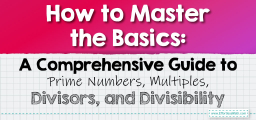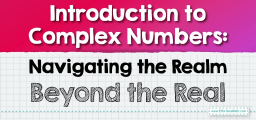How to Classify Numbers?
A number is an arithmetic value used to represent quantity and used in calculations. In this guide, you will be more familiar with the types of numbers and their properties.

We use numbers in our day-to-day life. They are often called numerals. The properties of numbers enable them to perform arithmetic operations on them.
A step-by-step guide to classifying numbers
Numbers are the main component of mathematics. Numbers are used to count, measure, sort things, list, and so on. We have different types of numbers based on their properties such as natural numbers, whole numbers, etc. We can perform basic arithmetic operations on numbers and determine the resulting number. Initially, tally marks were used before the use of numbers.
Types of numbers
Different types of numbers depend on their properties. Let’s learn more about different types of numbers.
- Cardinal numbers and ordinal numbers
A cardinal number is a number that represents the count of each object. Any natural number, such as \(1, 2, 3\), etc., is called a cardinal number, while an ordinal number is a number that indicates the position or place of an object. For example, \(1^{st},\:2^{nd},\:3^{rd},\:4^{th},\:5^{th}\), etc. Represents the order of things or objects, such as first, second, third, fourth, and so on.
Consecutive numbers are numbers that follow each other in order from the smallest number to the largest number. They usually have a difference of \(1\) between every two numbers.
- Integers
Integers are numbers that are made up of whole numbers and negative numbers. All integers are represented by the alphabet \(Z\) and have no decimal or fractional parts. A number line is full of integers. On the left side, you can find negative integers while on the right side, you have positive ones. Don’t forget the zero in between!
\(Z =[ …., -4, -3, -2, -1, 0 , 1, 2, 3, 4,….]\)
- Natural numbers and whole numbers
A natural number is a non-negative integer and is always greater than zero. It is indicated by the symbol \(N\). It should be noted that whole numbers do not contain any decimal or fractional parts. They are indicated by the symbol \(W\).
- Even numbers and odd numbers
Even numbers are numbers that can be divided into two equal groups or pairs and are exactly divisible by \(2\). In other words, these are whole numbers that are exactly divisible by \(2\).
Odd numbers are whole numbers that cannot be completely divided by two. These numbers cannot be arranged in pairs. Interestingly, all the whole numbers except the multiples of \(2\) are odd.
- Prime numbers and composite numbers
A prime number is a number that has exactly two factors, \(1\) and the number itself. For example, \(2, 5, 7, 11,\) and so on are prime numbers. It can be said that any whole number greater than \(1\) that has exactly two factors, \(1\), and itself is defined to be a prime number.
A composite number is a number that has more than two factors, that is, it can be divided by the number \(1\) and itself and at least one other integer. It can also be said that any number greater than \(1\) that is not a prime number is defined as a composite number. Composite numbers always have more than \(2\) factors. For example, \(6, 8, 9, 12\), and so on are composite numbers.
- Co-prime numbers
If a pair of numbers has no common factor apart from \(1\), then they are called co-prime numbers. In other words, a set of numbers or integers that have only \(1\) as their common factor, meaning that their highest common factor \((HCF)\) will be \(1\), are co-primes. These are also known as mutually prime numbers or relatively prime numbers. Also, there should be two numbers to form co-primes.
- Perfect numbers
Perfect numbers are positive integers that are equal to the sum of their factors except for the number itself. In other words, perfect numbers are positive integers that are the sum of their proper divisors. The smallest perfect number is \(6\), which is the sum of its proper divisors: \(1, 2\) and \(3\).
- Fractions and decimals
Fractions are part of a whole. They are represented by numbers that have two parts to them and they are separated by a fraction bar. There is a number at the top, which is called the numerator, and the number at the bottom is called the denominator.
A decimal number has a whole number part and a fractional part. These parts are separated by a decimal point. Decimals are interesting! They have a whole number part and they can also be represented as fractions.
- Rational numbers and irrational numbers
A rational number, denoted by \(Q,\) is represented in the form \(\frac{p}{q}\), where \(q\) is not equal to zero. Integers, fractions, decimals, whole numbers, and natural numbers are all rational numbers. For example, \(\frac{1}{2}\), \(-\frac{4}{5}\) are rational numbers.
Now, irrational numbers are numbers that cannot be represented using the integers in \(\frac{p}{q}\) form. The set of irrational numbers is denoted by \(Q’\). For example, \(\sqrt{5},\sqrt{2}\), etc. are irrational numbers. Irrational numbers cannot be represented as simple fractions. The decimal expansion neither terminates nor becomes periodic.
- Real numbers
Any number found in the real world is a real number. Any number we can think of, except complex numbers, is a real number. The set of real numbers is the union of the set of Rationals \((Q)\) and Irrationals \((Q’)\). It is denoted by \(R\). The set of real numbers, \(R = Q ∪ Q’\).
The following figure shows the relationship between real numbers, rational numbers, irrational numbers, integers, whole numbers, and natural numbers.
- Complex numbers
A complex number is a number that can be expressed in the form \((a+bi)\), where \(a\) and \(b\) are real numbers, and \(i\) is a solution of the equation \(i^2 = −1\). Since no real number satisfies this equation, \(i\) is called an imaginary number. Complex numbers have a real part and an imaginary part.
Classify Numbers – Example 1:
Classify the following numbers as even numbers and odd numbers: \(1, 3, 4, 7, 12, 21, 29, 32\)
Solution:
Even numbers are numbers that are precisely divisible by \(2\). Thus \(4, 12\), and \(32\) are even numbers, while odd numbers are numbers that are not divisible by \(2\). Therefore, odd numbers are \(1, 3, 7, 21,\) and \(29\).
Exercises for Classifying Numbers
- Find the missing number in the series: \([5, 9, 13, …, 21, 25, 29, 33]\).
- Determine the natural numbers among the following numbers \([-1, 0, 3, \frac{1}{2}, 5]\).
- Write the first five composite numbers.

- \(\color{blue}{17}\)
- \(\color{blue}{3,5}\)
- \(\color{blue}{4, 6, 8, 9, 10}\)
Related to This Article
More math articles
- Addition of 3-Digit Numbers
- 10 Most Common 3rd Grade FSA Math Questions
- The Best PERT Math Worksheets: FREE & Printable
- How to Factor Quadratics Using Algebra Tiles
- How to Study for a Math Test in 7 Easy Steps
- Studying Math Can Foster Analytical Skills
- Best Cheap Laptops for College Students
- How Good Do You Need to Be at Math to Play Baccarat?
- 8th Grade FSA Math Practice Test Questions
- The Ultimate MCAP Algebra 1 Course (+FREE Worksheets)


























What people say about "How to Classify Numbers? - Effortless Math: We Help Students Learn to LOVE Mathematics"?
No one replied yet.